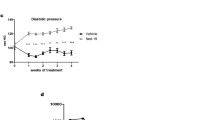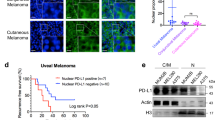Abstract
A more complete understanding of the mechanisms that regulate the angiogenic switch, which contributes to the conversion of small dormant tumors to actively growing malignancies, is important for the development of more effective anti-angiogenic strategies for cancer therapy. While significant progress has been made in understanding the complex mechanisms by which integrin αvβ3 expressed in endothelial cells governs angiogenesis, less is known concerning the ability of αvβ3 expressed within the tumor cell compartment to modulate the angiogenic output of a tumor. Here we provide evidence that αvβ3 expressed in melanoma cells may contribute to the suppression of IGFBP-4, an important negative regulator of IGF-1 signaling. Given the multiple context-dependent roles for αvβ3 in angiogenesis and tumor progression, our novel findings provide additional molecular insight into how αvβ3 may govern the angiogenic switch by a mechanism associated with a p38 MAPK and matrix metalloproteinases-dependent regulation of the endogenous angiogenesis inhibitor IGFBP-4.








Similar content being viewed by others
References
Varney ML, Jonansson SL, Singh RK (2005) Tumor-associated infiltration, neovascularization and aggressiveness in malignant melanoma: role of monocyte chemotactic protein-1 and vascular endothelial growth factor-A. Melanoma Res 15:417–425
Demirkesen C, Buyukpinarbasili N, Ramazangoglu R, Ollguz O, Mandel NM et al (2006) The correlation of angiogenesis with metastasis in primary cutaneous melanoma: a comparative analysis of microvessel density, expression of vascular endothelial growth factor and basic fibroblast growth factor. Pathology 38:132–137
Massi D, Franchi A, Borgognoni L, Paglierani M, Reali UM et al (2002) Tumor angiogenesis as a prognostic factor in thick cutaneous malignant melanoma. A quantitative morphological analysis. Virchow Arch 440:22–28
Wu S, Singh S, Varney ML, Kindle S, Singh RK (2012) Modulation of CXCL-8 expression in human melanoma cells regulates tumor growth, angiogenesis, invasion, and metastasis. Cancer Med 3:306–317
Naumov GN, Bender E, Zurakowski D, Kang SY, Sampson D et al (2006) A model of human tumor dormancy: an angiogenic switch from the nonangiogenic phenotype. J Natl Cancer Inst 98:316–325
Contois L, Akalu A, Brooks PC (2009) Integrins as functional hubs in the regulation of pathological angiogenesis. Semin Cancer Biol 19:318–328
Indraccolo S (2013) Insights into the regulation of tumor dormancy by angiogenesis in experimental tumors. Adv Exp Med Biol 734:37–52
Kang SY, Watnick RS (2008) Regulation of tumor dormancy as a function of tumor-mediated paracrine regulation of stromal Tsp-1 and VEGF. APMIS 116:638–647
Almog N, Ma L, Rachowdhury R, Schwager C, Erber R et al (2009) Transcriptional switch of dormant tumors to fast growing angiogenic phenotype. Cancer Res 69:836–944
Moserle L, Amadori A, Indraccolo S (2009) The angiogenic switch: implications in the regulation of tumor dormancy. Curr Mol Med 8:935–941
Chung AS, Lee J, Ferrara N (2010) Targeting the tumor vasculature: insight from physiological angiogenesis. Nat Rev Cancer 10:505–513
Carmeliet P, Jain RK (2011) Molecular mechanisms and clinical applications of angiogenesis. Nature 473:298–307
Weis SM, Cheresh DA (2011) Tumor angiogenesis: molecular pathways and therapeutic targets. Nat Med 17:1359–1369
Ebos JM, Lee CR, Kerbel RS (2009) Tumor and host-mediated pathways of resistance and disease progression in response to anti-angiogenic therapy. Clin Cancer Res 16:5020–5025
Ebos JM, Lee CR, Cruz-Munzo W, Bjarmason GA, Christensen JG et al (2009) Accelerated metastasis after short-term treatment with a potent inhibitor of tumor angiogenesis. Cancer Cell 15:232–239
Paez-Ribes M, Allen E, Hudock J, Takeda T, Okuyama H et al (2009) Antiangiogenic therapy elicits malignant progression of tumors to increase local invasion and distant metastasis. Cancer Cell 15:220–231
Hangai M, Kitaya N, Chan CK, Kim JJ, Werb Z et al (2002) Matrix metaaloproteinase-9-dependent exposure of a cryptic migratory control site in collagen is required before retinal angiogenesis. Am J Pathol 161:1429–1437
Chen Q, Jin M, Yang F, Zhu J, Xiao Q et al (2013) Matrix metalloproteinases: inflammatory regulators of cell behavior in vascular formation and remodeling. Mediators Inflamm. doi:10.1155/2013/928315
Xu X, Rodriguez D, Petitclerc E, Kim JJ, Hangai M et al (2001) Proteolytic exposure of a cryptic site within collagen type-IV is required for angiogenesis and tumor growth in vivo. J Cell Biol 154:1069–1079
Lu P, Weaver VM, Werb Z (2012) The extracellular matrix: a dynamic niche in cancer progression. J Cell Biol 196:395–406
Assal Y, Mie M, Kobatake E (2013) The promotion of angiogenesis by growth factors integrated with ECM proteins through coiled-coil structures. Biomaterials 34:3315–3323
Davis GE (2011) Angiogenesis and proteinase: influence on vascular morphogenesis, stabilization and regression. Drug Discov Today Dis Models 8:13–20
Sweet DT, Chen Z, Wiley DM, Bautch VL, Tzima E (2012) The adaptor protein Shc integrates growth factor and ECM signaling during postnatal angiogenesis. Blood 119:1946–1955
Sacharidou A, Stratman AN, Davis GE (2012) Molecular mechanisms controlling vascular lumen formation in three-dimensional extracellular matrices. Cells Tissues Organs 195:122–143
Petitclerc E, Boutaud A, Prestrayko A, Xu J, Sado Y et al (2000) New functions for non-collagenous domains of human collagen type-IV: novel integrin ligands inhibiting angiogenesis and tumor growth in vivo. J Biol Chem 275:8051–8061
Ren B, Yee KO, Lawer J, Khosrav-Far J (2006) Regulation of tumor angiogenesis by thrombospondin-1. Biochim Biophys Acta 1765:178–188
Desgrosellier JS, Cheresh DA (2010) Integrins in cancer: biological implications and therapeutic opportunities. Nat Rev Cancer 10:9–22
Brooks PC, Clark RA, Cheresh DA (1994) Requirement of vascular integrin αvβ3 for angiogenesis. Science 264:569–571
Brooks PC, Montgomery AM, Rosenfeld M, Reisfeld RA, Hu T et al (1994) Integrin αvβ3 antagonists promote tumor regression by inducing apoptosis of angiogenic blood vessels. Cell 79:1157–1164
Delbaldo C, Raymond E, Vera K, Hammershaimb L, Kaucic K et al (2008) Phase I and pharmacokinetic study of etaracizumab (Abegrin), a humanized monoclonal antibody against αvβ3 integrin receptor, in patients with advanced solid tumors. Investig New Drug 26:35–43
Scaringi C, Minniti G, Caporello P, Enrici RM (2012) Integrin inhibitor cilengitide for the treatment of glioblastoma: a brief overview of current clinical results. Anticancer Res 32:4213–4223
Reynolds LE, Wyder L, Lively JC, Taverna D, Robinson SD et al (2002) Enhanced pathological angiogenesis in mice lacking β3 integrin or β3 and β5 integrins. Nat Med 8:27–34
Taverna D, Moher H, Crowley D, Borsig L, Varki A et al (2004) Increased primary tumor growth in mice null for β3 or β3 and β5 integrins or selectins. Proc Natl Acad Sci USA 101:763–768
Feng W, McCabe P, Mahabeleshwar GH, Samanath PR, Phillips DR et al (2008) The angiogenic response is dictated by β3 integrin on bone marrow-derived cells. J Cell Biol 182:1145–1157
Cretu A, Roth JM, Caunt M, Akalu A, Policarpio D et al (2007) Disruption of endothelial cell interactions with the novel HU177 cryptic collagen epitope inhibits angiogenesis. Clin Cancer Res 13:3068–3078
Akalu A, Roth JM, Caunt M, Policarpio D, Liebes L et al (2007) Inhibition of angiogenesis and tumor metastasis by targeting a matrix immobilized cryptic extracellular matrix epitope in laminin. Cancer Res 67:4353–4363
Contois LW, Nugent DP, Caron JM, Cretu A, Tweedie E et al (2012) Insulin-like growth factor binding protein-4 differentially inhibits growth factor-induced angiogenesis. J Biol Chem 287:179–189
Smith LEH, Shen W, Perruzzi C, Soker S, Kinose F et al (1999) Regulation of vascular endothelial growth factor-dependent retinal neovascularization by insulin-like growth factor-1 receptor. Nat Med 12:1390–1395
Moreno MJ, Ball M, Andrade MF, Mcdermid A, Stanimirovic DB (2006) Insulin-like growth factor binding protein-4 (IGFBP-4) is a novel anti-angiogenic and anti-tumorigenic mediator secreted by dibutyryl cyclic AMP (dB-cAMP)-differentiated glioblastoma cells. Glia 63:845–857
Beattie J, McIntosh L, Walle V (2010) Cross talk between the insulin-like growth factor (IGF) axis and membrane integrins to regulate cell physiology. J Cell Physiol 224:605–611
Rossello A, Orlandini E, Carelli P, Rapposelli S, Macchia M et al (2004) New N-arylsulfonyl-N-alkoxyaminoacetohydroxamic acids as selective inhibitors of gelatinase A (MMP2). Bioorg Med Chem 12:2441–2450
Freimark B, Clark D, Pernasetti F, Nickel J, Myszka D et al (2007) Targeting of humanized antibody D93 to sites of angiogenesis and tumor growth by binding to multiple epitopes on denatured collagens. Mol Immunol 44:3741–3750
Mondy WL, Cameron D, Timmermans JP, De Clerck N, Sasov AC et al (2009) Micro-CT or corrosion casts for use in the computer-aided design of microvasculature. Tissue Eng Part C Methods 15:729–738
Felding-Habermann B, Mueller BM, Romerdahi CA, Cheresh DA (1992) Involvement of integrin alpha v expression in human melanoma tumorigenicity. J Clin Investig 89:2018–2022
Durai R, Davis M, Yang W, Yang SY, Seifalian A et al (2006) Biology of insulin-like growth factor binding protein-4 and its role in cancer. Int J Oncol 28:1317–1325
Yu JZ, Warycha MA, Christos PJ, Darvishian F, Yee H et al (2008) Assessing the clinical utility of measuring insulin-like growth factor binding proteins in tissues and sera from melanoma patients. J Transl Med 6:70. doi:10.1186/1479-5876-6-70
Estrada Y, Dong J, Ossowski L (2009) Positive crosstalk between Erk and p38 in melanoma stimulates migration and in vivo proliferation. Pigment Cell Melanoma Res 22:66–76
Hennig T, Mogensen C, Kirsch J, Pohl U, Gloe T et al (2011) Shear stress induces the release of an endothelial elastase: role in integrin αvβ3-mediated FGF-2 release. Vasc Res 48:453–464
Nakamura M, Miyamoto S, Maeda H, Ishii G, Hasebe T et al (2005) Matrix metalloproteinase-7 degrades all insulin-like growth factor binding proteins and facilitates insulin-like growth factor bioavailability. Biochem Biophys Res Commun 333:1011–11016
Prudova A, auf dem Keller U, Butler GS, Overall CM (2010) Multiplex N-terminome analysis of MMP-2 and MMP-9 substrate degradomes by iTRAQ-TAILS quantitative proteomics. Mol Cell Proteomics. doi:10.1074/mcp.M000050-MCP201
Denkert C, Siegert A, Leclere A, Turznski A, Hauptmann S (2002) An inhibitor of stress-activated MAP-kinase reduces invasion and MMP-2 expression of malignant melanoma cells. Clin Exp Metastasis 19:79–85
Gomes LR, Terra LF, Wailemann RA, Labriola L, Sogayar MC (2012) TGF-β1 modulates the homeostasis between MMPs and MMP inhibitors through p38 MAPK and ERK1/2 in highly invasive breast cancer cells. BMC Cancer. doi:10.1186/1471-2407-12-26
Reynolds AR, Reynolds LE, Nagel TE, Robinson SD, Hicklin DJ et al (2004) Elevated FLK1 (vascular endothelial growth factor receptor 2) signaling mediates enhanced angiogenesis in β3-integrin-deficient mice. Cancer Res 64:8643–8650
Waston RA, Pitchford SC, Reynolds LE, Direkze N, Alison MR et al (2010) Deficiency of bone marrow β3-integrin enhances non-functional neovascularization. Am J Pathol 220:435–445
Steri V, Ellison TS, Gontarczyk AM, Weilbaecher K, Scheider JG et al (2014) Acute depletion of endothelial β3-integrin transiently inhibits tumor growth and angiogenesis in mice. Circ Res 114:79–91
Robinson SD, Hodivala-Dilke KM (2011) The role of β3-integrins in tumor angiogenesis: context is everything. Curr Opin Cell Biol 23:630–670
Friedlander M, Brooks PC, Shaffer RW, Kincaid CM, Varner JA et al (1996) Definition of two angiogenic pathways by distinct αv integrins. Science 270:1500–1502
Lorger M, Krueger JS, O’Neal M, Staflin K, Felding-Habermann B (2009) Activation of tumor cell integrin αvβ3 controls angiogenic and metastatic growth in the brain. Proc Natl Acad Sci USA 106:10666–10671
Gloe T, Sohn HY, Meininger GA, Pohl U (2002) Shear stress-induced release of basic fibroblast growth factor from endothelial cells is mediated by matrix interaction via integrin αvβ3. J Biol Chem 277:23453–23458
Stromblad S, Becker JC, Yebra M, Brooks PC, Cheresh DA (1996) Suppression of p53 activity and p21WAF1/CIP1 expression by vascular cell integrin αvβ3 during angiogenesis. J Clin Investig 98:426–433
Bao W, Stomblad S (2004) Integrin αv-mediated inactivation of p53 controls a MEK1-dependent melanoma cell survival pathway in three-dimensional collagen. J Cell Biol 167:745–756
Teodora JG, Parker AE, Zhu X, Green MR (2006) P53-mediated inhibition of angiogenesis through up-regulation of a collagen prolyl hydroxylase. Science 313:968–997
Acknowledgments
This work was supported in part by National Institutes of Health grants CA91645 (to P.C.B), Grant HL65301 (to R.F), Grants HL083151 and P20RR15555 (Protein, Nucleic Acid Analysis) to (C.P.H.V.), and Grant P20 RR181789 (Bioinformatics Core) to D. M. Wojchowski. This work was also supported by NIH Center of Biomedical Research Excellence 5P30GM103392 (PI: R. Friesel), the Maine Cancer Foundation (MCF) grant to L. W. C., and by institutional support from the Maine Medical Center.
Conflict of interest
The authors declare no conflict of interest.
Author information
Authors and Affiliations
Corresponding author
Rights and permissions
About this article
Cite this article
Contois, L.W., Akalu, A., Caron, J.M. et al. Inhibition of tumor-associated αvβ3 integrin regulates the angiogenic switch by enhancing expression of IGFBP-4 leading to reduced melanoma growth and angiogenesis in vivo. Angiogenesis 18, 31–46 (2015). https://doi.org/10.1007/s10456-014-9445-2
Received:
Accepted:
Published:
Issue Date:
DOI: https://doi.org/10.1007/s10456-014-9445-2




